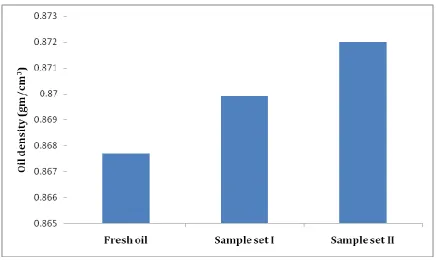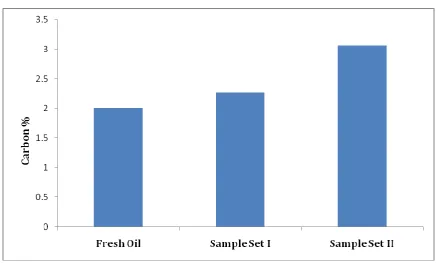International Research Journal of Engineering and Technology (IRJET)
e-ISSN: 2395-0056Volume: 06 Issue: 11 | Nov 2019 www.irjet.net p-ISSN: 2395-0072
STUDY OF DEGRADATION OF LUBRICANTS USED ON SECTIONAL
WARPING MACHINE
Irshad M. Momin
1, Sunil B. Mhetre
21
Assistant Professor, DKTE Society’s Textile & Engineering Institute, Ichalkaranji, Maharashtra, India
2
Associate Professor, DKTE Society’s Textile & Engineering Institute, Ichalkaranji, Maharashtra, India
---***---Abstract - The Indian Textile Industry, though one of the oldest in India, has not given due importance to lubrication. Lubrication system is critical in many industries and it is equally important in the Textile Industry. The basic problem in the lubrication of Textile machinery is that the product comes into intimate contact with the machine parts and any contamination of the product or the lubricant cannot be tolerated. Present-day, textile machines are becoming more and more sophisticated and complex with the use of various types of drives, components moving at widely varying speeds and working under different loads. The new machines are designed with a view to work them at very high speeds over long periods without major break- down. Lubrication, therefore, is becoming more and more critical in maintaining both the efficiency and reliability of machines and thereby, the quality of the finished product. It has been observed and confirmed that a majority of the problems and breakdowns on machines occur due to faulty lubrication. With the establishment of mass production, quality consciousness among the buyers & the competitive market of textiles, keeping the overall production cost under the reasonable control, is need of time. This can be achieved only when the effective maintenance with lubrication is given prime importance. Effective performance of machine requires careful selection of lubrication system, the lubrication which gives long life to machine.
Key Words: Sectional warping, viscosity, flammability, flash point, pour point, spectroscopy.
1. INTRODUCTION
Today’s weaving preparatory machines give much faster production because of high speed of warping machine up to 1200 mpm. Lubrication plays important role in maintenance of weaving preparatory machine. Good lubrication practices give high speed as well as high efficiency. The advancement in the environmental condition of industrial machinery working such as high temperature, high pressure and dynamic condition has demanded the new characteristically requirement of lubricant and their properties. The fluid lubricants are commonly used for reduction of wear, elimination of heat and corrosion etc.
2. Material & methods used:
The material and equipment used for the various types of oil and its testing are as follows. Oil samples are collected from headstock zone of Sectional warping machine. Type of oil used is Hydraulic oil shell S1M46. The samples collected are as follows:
1) Fresh oil.
2) Sample I – One year used oil and
3) Sample II – One year & three months used oil.
3. Results & discussions:
To study the extent of lubricating oil degradation, testing of the following oil properties were carried out.
3.1 Oil viscosity:
Figure 1: Viscosity results of selected oil samples.
The concentration is amount of substance dissolved in a specific volume, because of temperature, heat dissipation and thermal breakdown. Concentration decreases which results in decreasing oil viscosity. The particle of same substance has an attractive force. Some substance has strong attractive force while other substance has weak attractive force, because of addition of contaminants it will affect the attractive force and cause decrease in oil viscosity. Due to various motions in gear box, shear force acts on lubricant which cause thinning of lubrication film resulting in decrease of viscosity. During actual working and during maintenance work such as cleaning, the foreign particles get added to lubricants which hampers viscosity.
3.2 Oil density:
Following oil density results were obtained by testing given oil and density is measured in gm/cm3.
Figure 2: Density results of selected oil samples.
[image:2.595.89.526.452.713.2]International Research Journal of Engineering and Technology (IRJET)
e-ISSN: 2395-0056Volume: 06 Issue: 11 | Nov 2019 www.irjet.net p-ISSN: 2395-0072
3.3 Pour point:
[image:3.595.101.496.161.371.2]Following oil pour point results were obtained by testing given oil samples. It has been observed that oil pour point increases after certain period of time. The reasons behind the increase in oil pour point may be one or more of the following - cooling rate, formation of large crystal during solidification, temperature, improper additives or contaminants present in oil etc.
Figure 3: Pour point results of selected oil samples.
3.4 Oil flammability:
Following flash point & fire point results were obtained by testing selected oil samples. It has been observed that flash and fire point of oil increases after certain period of time, actually the flash and fire point should decrease. But due to addition of wear particles in oil, oil cracking, contamination, wrong mixing of oil etc. flash and fire point increases.
[image:3.595.86.527.462.720.2]Figure 5 : Fire point results of selected oil samples.
3.5 Carbon residue test:
Following carbon percentage results were obtained by testing selected oil samples. Results are reported in %.
Figure 6: Carbon % results of selected oil samples.
[image:4.595.79.519.413.676.2]International Research Journal of Engineering and Technology (IRJET)
e-ISSN: 2395-0056Volume: 06 Issue: 11 | Nov 2019 www.irjet.net p-ISSN: 2395-0072
4. Spectroscopy:
[image:5.595.65.534.138.356.2]Sectional warping machine
Figure 7 : Headstock zone - Overlap Fresh and used oil sample 1.
Figure 8 : Headstock zone - Overlap Fresh and used oil sample 2.
Discussion:
[image:5.595.67.527.388.611.2]Spectrum location:
Table : Spectrum location of sectional warping machine oil.
Spectrum location (cm-1) Change in absorbency
Fig a. Fig b.
675 - 1000 0.04 – 0.05 0.03 – 0.06
1400 – 1600 0.13 – 0.11 0.05 – 0.07
2840 – 3000 0.21 – 0.15 & 0.29 – 0.21 0.27 – 0.21 & 0.17 – 0.15
Table 1: Spectrum location of Sectional warping machine oil.
Reasons for change in absorbency:
1. Heat absorption capacity: During the actual working the heat generation takes place which affects the absorbency capacity of molecules.
2. Molecular forces or bond strength decreases: Because of heat generation the bond strength between molecules decreases which causes change in absorbency.
3. Addition of water or increase in acid number: Because of continuous action, breakdown of molecules takes place and free – OH group gets attached to the free branch of carbon. The absorbency capacity of original compound and newly formed compound is different.
4. Addition of unsaturated group: Addition of unsaturated compound like alkene or alkyne causes change in absorbency level.
5. Color change due to addition of fine particle: Because of continuous working, addition of worn-out metal particles, addition of contaminant causes change in color of oil.
6. Intensity: The intensity is nothing but intensity of IR radiation. The change in intensity of IR radiation at the particular testing time causes difference in absorbency.
7. Opaque: Some time the oil under testing shows opaque nature which avoid penetration of IR radiation and causes change in absorbency level.
5. CONCLUSION
A well balanced oil analysis program can monitor machine wear condition, oil contamination and oil degradation simulateneously. There are many different approaches to implement an oil analysis program, depending on the application and maintenance objectives. The result presented by fresh and used oil of sectional warping machine shows that there is a considerable change in oil properties of fresh oil than used oil. The spectroscopy graph also shows change in absorbency level from this, the entire oil change frequency is predicted up to 6 years.
ACKNOWLEDGEMENT
The authors are very much thankful to the management of DKTE Society’s Textile and Engineering Institute, Ichalkaranji, Maharashtra, India for their constant encouragement and motivation in publishing this article.
REFERENCES
[1] Yuegang Zhao, Oil Analysis Handbook for Predictive Equipment Maintenance, pp.25(2014).
[2] Harish Hirani “Online Condition Monitoring of high speed gears using vibration and Oil Analysis”, Thermal Fluid and
Manufacturing Science (2012).
[3] N. Robinson, “Monitoring Oil degradation with Infrared Spectroscopy”, Wear check Technical Bulletin (2000).
[4] Michael Garry, John Bowman “FT-IR analysis of used lubricating oils – General considerations”, Thermo scientific, WI USA
International Research Journal of Engineering and Technology
(IRJET)
e-ISSN: 2395-0056Volume: 06 Issue: 11 | Nov 2019 www.irjet.net p-ISSN: 2395-0072
BIOGRAPHIES
Irshad M. Momin is working as Assistant Professor in DKTE Society’s Textile and Engineering Institute, Ichalkaranji, Maharashtra, India. He is having 14 years of teaching experience and 4 years of industrial experience.



